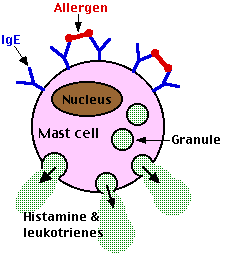Asthma
The Problem
The incidence of asthma in the United States (as well as in many other developed countries) has reached epidemic proportions. In the last 17 years, the number of sufferers in the U. S. has doubled to more than 14 million people.
In an attack of asthma, the bronchi become constricted, making it difficult to breathe in and - especially - out. The victim wheezes and coughs. Severe attacks can be life-threatening.
The Mechanism
 An attack of asthma begins when an allergen is inhaled. The allergen binds to IgE antibodies - those that have binding sites for the allergen - on mast cells in the lungs. Binding triggers exocytosis of the mast cells with the release of
An attack of asthma begins when an allergen is inhaled. The allergen binds to IgE antibodies - those that have binding sites for the allergen - on mast cells in the lungs. Binding triggers exocytosis of the mast cells with the release of
- histamine and
- leukotrienes
These substances
- cause the smooth muscle cells of the bronchi to contract narrowing the lumen of the bronchi. This is the early phase.
- attract an accumulation of inflammatory cells - especially eosinophils - and the production of mucus. This is the late phase. With repeated attacks, the lining of the bronchi becomes damaged.
Although asthma begins as an allergic response, in time attacks can be triggered by nonspecific factors like cold air, exercise, and tobacco smoke.
Why do some people develop asthma from exposure to agents that are harmless to others?
For reasons that are not yet understood, some people have a predisposition to respond to antigens by making antibodies of the IgE class. The trait tends to run in families so there is probably a genetic component. These people are said to suffer from atopy.
The T helper cells of atopic people are largely of the Th2 type rather that Th1.
Th2 helper cells
- help B cells make IgE antibodies by synthesizing interleukin 4 (IL-4) and interleukin 13 (IL-13), which promote class switching.
- release interleukin 5 (IL-5) which attracts eosinophils and other inflammatory cells to the site, producing the late phase of the response.
Why is asthma a disease of developed countries?
No one knows for certain.
It is certainly not a matter of air pollution. Air pollution can trigger attacks of asthma, but some regions with heavily-polluted air have much lower incidences of asthma than regions with relatively clean air.
One intriguing possibility: widespread childhood immunization may enable children to avoid the infections - especially viral - that stimulate the immune system to respond with Th1 helper cells rather than Th2 cells. Children in Europe that give positive DTH responses to tuberculin (a response mediated by Th1 cells) have lower rates of asthma than children who are negative in the tuberculin test.
Treatments
- These drugs (albuterol is a popular example) mimic the action of adrenaline.
- They relax the smooth muscle of the bronchi.
- They may be inhaled or given by injection.
- While useful in the early phase of an attack, they provide no protection against the longterm damage produced during the late phase.
- These drugs reduce the inflammation of the late phase of the response.
- They may be given in an inhaler (e.g., beclomethasone) or by mouth (e.g., prednisone)
Cromolyn sodium
Cromolyn sodium (disodium cromoglycate)
- inhibits exocytosis of mast cells thus blocking the release of histamine and leukotrienes.
- It is used mainly to prevent attacks (e.g., triggered by exercise) and is of no use in the early phase of an ongoing attack.
Two types of leukotriene inhibitors received FDA approval in 1996.
- Zileuton (trade name = "Zyflo") blocks leukotriene synthesis by inhibiting the action of 5-lipoxygenase.
- Zafirlukast (trade name = "Accolate") blocks the leukotriene receptors on the surface of
- smooth muscle cells
- eosinophils
Possible future treatments still under investigation
- Anti-IgE antibodies. These would block the action of IgE but will have to tailored so they do not induce an immune response in the patient that would soon render them useless.
- Drugs that bind to IL-13 keeping it from promoting IgE synthesis.
- Treatments that stimulate the production of Th1 cells by the immune system. Injections of a harmless mycobacterium (a relative of the TB bacillus) might do the trick. Th1 cells secrete interferon-gamma which is a powerful inhibitor of Th2 cells. [Discussion with graphic]
Some of these treatments are already in clinical trials. [Discussion of how new drugs are tested]
22 February 1999
 An attack of asthma begins when an allergen is inhaled. The allergen binds to IgE antibodies - those that have binding sites for the allergen - on mast cells in the lungs. Binding triggers exocytosis of the mast cells with the release of
An attack of asthma begins when an allergen is inhaled. The allergen binds to IgE antibodies - those that have binding sites for the allergen - on mast cells in the lungs. Binding triggers exocytosis of the mast cells with the release of